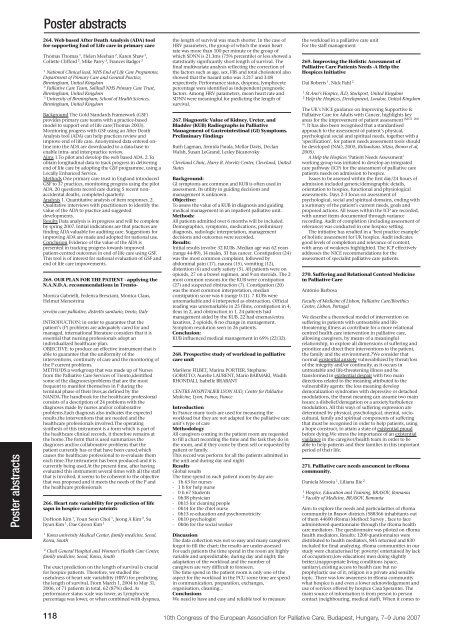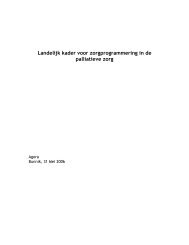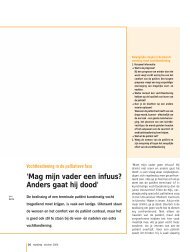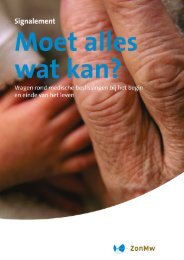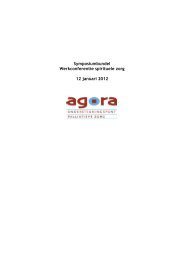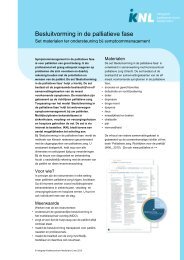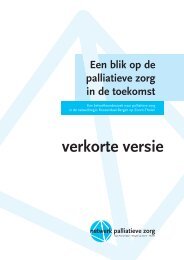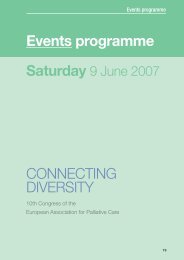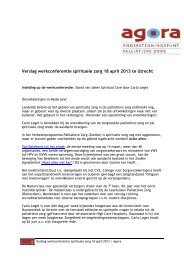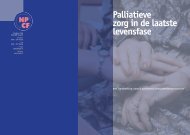Poster abstracts CONNECTING DIVERSITY
Poster abstracts CONNECTING DIVERSITY
Poster abstracts CONNECTING DIVERSITY
You also want an ePaper? Increase the reach of your titles
YUMPU automatically turns print PDFs into web optimized ePapers that Google loves.
<strong>Poster</strong> <strong>abstracts</strong><br />
<strong>Poster</strong> <strong>abstracts</strong><br />
264. Web based After Death Analysis (ADA) tool<br />
for supporting End of Life care in primary care<br />
Thomas Thomas 1 , Helen Meehan 2 , Karen Shaw 3 ,<br />
Collette Clifford 3 , Mike Parry 3 , Frances Badger 3<br />
1<br />
National Clinical lead, NHS End of Life Care Programme,<br />
Department of Primary Care and General Practice,<br />
Birmingham, United Kingdom<br />
2<br />
Palliative Care Team, Solihull NHS Primary Care Trust,<br />
Birmingham, United Kingdom<br />
3<br />
University of Birmingham, School of Health Sciences,<br />
Birmingham, United Kingdom<br />
Background The Gold Standards Framework (GSF)<br />
provides primary care teams with a practice-based<br />
model to support end of life care(Thomas 2003).<br />
Monitoring progress with GSF using an After Death<br />
Analysis tool (ADA) can help practices review and<br />
improve end of life care. Anonymised data entered online<br />
into the ADA are downloaded to a data-base to<br />
enable intra- and inter-practice review.<br />
Aims 1.To pilot and develop the web based ADA. 2.To<br />
obtain longitudinal data to track progress in delivering<br />
end of life care by adopting the GSF programme, using a<br />
Locally Enhanced Service.<br />
Methods One primary care trust in England introduced<br />
GSF to 37 practices, monitoring progress using the pilot<br />
ADA. 20 questions record care during 5 recent nonaccidental<br />
deaths, completed quarterly.<br />
Analysis 1. Quantitative analysis of item responses. 2.<br />
Qualitative interviews with practitioners to identify the<br />
value of the ADA to practice and suggested<br />
developments.<br />
Results Data analysis is in progress and will be complete<br />
by spring 2007. Initial indications are that practices are<br />
finding ADA valuable for auditing care. Suggestions for<br />
improving ADA are made and adopted for national use.<br />
Conclusion Evidence of the value of the ADA is<br />
presented in tracking progress towards improved<br />
patient-centred outcomes in end of life care using GSF.<br />
This tool is of interest for national evaluation of GSF and<br />
end of life care improvements.<br />
265. OUR PLAN FOR THE PATIENT - applying the<br />
N.A.N.D.A. recommendations in Trento-<br />
Monica Gabrielli, Federica Bresciani, Monica Claus,<br />
Helmut Menestrina<br />
servizio cure palliative, distretto sanitario, trento, Italy<br />
INTRODUCTION: in order to guarantee that the<br />
patient’s (P) problems are adequately cared for and<br />
managed, international literature considers that it is<br />
essential that nursing professionals adopt an<br />
individualized healthcare plan.<br />
OBJECTIVE: to produce an effective instrument that is<br />
able to guarantee that the uniformity of the<br />
interventions, continuity of care and the monitoring of<br />
the P current problems.<br />
METHODS:a workgroup that was made up of Nurses<br />
from the Palliative Care Services of Trento,identified<br />
some of the diagnoses/problems that are the most<br />
frequent to manifest themselves in P during the<br />
terminal phase of their lives,as defined by the<br />
NANDA.The handbook for the healthcare professional<br />
consists of a description of 24 problems with the<br />
diagnoses made by nurses and/or collaborative<br />
problems.Each diagnosis also indicates the expected<br />
results,the interventions that are needed and the<br />
healthcare professionals involved.The operating<br />
synthesis of this instrument is a form which is part of<br />
the healthcare clinical records, it therefore remains at<br />
the home.The form that is used summarizes the<br />
diagnoses and/or collaborative problems that the<br />
patient currently has or that have been cured,which<br />
causes the healthcare professional to re-evaluate them<br />
each time.The instrument has been produced and it is<br />
currently being used.At the present time, after having<br />
evaluated this instrument several times with all the staff<br />
that is involved, it seems to be coherent to the objective<br />
that was proposed and it meets the needs of the P and<br />
the healthcare professionals<br />
266. Heart rate variability for prediction of life<br />
sapn in hospice cancer pateints<br />
DoHoon Kim 1 , Youn Seon Choi 1 , Jeong A Kim 2 , Su<br />
hyun Kim 1 , Dae Gyeon Kim 1<br />
1<br />
Korea university Medical Center, family medicine, Seoul,<br />
Korea, South<br />
2<br />
Cheil General Hospital and Women’s Health Care Center,<br />
family medicine, Seoul, Korea, South<br />
The exact prediction on the length of survival is crucial<br />
for hospice patients. Therefore, we studied the<br />
usefulness of heart rate variability (HRV) for predicting<br />
the length of survival. From March 1, 2004 to May 31,<br />
2006, of 71 patients in total, 62 (87%) died. As<br />
performance status scale was lower, as Lymphocyte<br />
percentage was lower, or when combined with dyspnea,<br />
the length of survival was much shorter. In the case of<br />
HRV parameters, the group of which the mean heart<br />
rate was more than 100 per minute or the group of<br />
which SDNN is 21.3ms (75% percentile) or less showed a<br />
statistically significantly short length of survival. The<br />
final multivariate analysis reflecting the correction of<br />
the factors such as age, sex, FBS and total cholesterol also<br />
showed that the hazard ratio was 3.217 and 3.08<br />
respectively. Performance status, dyspnea, lymphocyte<br />
percentage were identified as independent prognostic<br />
factors. Among HRV parameters, mean heart rate and<br />
SDNN were meaningful for predicting the length of<br />
survival.<br />
267. Diagnostic Value of Kidney, Ureter, and<br />
Bladder (KUB) Radiographs in Palliative<br />
Management of Gastrointestinal (GI) Symptoms.<br />
Preliminary Findings<br />
Ruth Lagman, Armida Parala, Mellar Davis, Declan<br />
Walsh, Susan LeGrand, Lesley Bicanovsky<br />
Cleveland Clinic, Harry R. Horvitz Center, Cleveland, United<br />
States<br />
Background:<br />
GI symptoms are common and KUB is often used in<br />
assessment. Its utility in guiding decisions and<br />
management is unknown.<br />
Objective:<br />
To assess the value of a KUB in diagnosis and guiding<br />
medical management in an inpatient palliative unit.<br />
Methods:<br />
All patients admitted over 6 months will be included.<br />
Demographics, symptoms, medications, preliminary<br />
diagnosis, radiologic interpretation, management<br />
decisions and outcomes were recorded.<br />
Results:<br />
Initial results involve 32 KUBs .Median age was 62 years<br />
(range 44-89), 14 males, 31 has cancer. Constipation (24)<br />
was the most common complaint, followed by<br />
abdominal pain (17), nausea (15), vomiting (12),<br />
distention (6) and early satiety (5). All patients were on<br />
opioids, 27 on a bowel regimen, and 9 on steroids. The 2<br />
most common reasons for the KUB were constipation<br />
(27) and suspected obstruction (7). Constipation (20)<br />
was the most common interpretation, median<br />
constipation score was 6 (range 0-11). 7 KUBs were<br />
unremarkable and 4 interpreted as obstruction. Official<br />
reading was unremarkable in 25 films, constipation in 4,<br />
ileus in 2, and obstruction in 1. 24 patients had<br />
management aided by the KUB. 22 had enemas/extra<br />
laxatives, 2 opioids, 8 no change in management.<br />
Symptom resolution seen in 26 patients.<br />
Conclusion:<br />
KUB influenced medical management in 69% (22/32).<br />
268. Prospective study of workload in palliative<br />
care unit<br />
Marilene FILBET, Marina PORTIER, Stephane<br />
GOBATTO, Aurelie LAURENT, Mario BARMAKI, Wadih<br />
RHONDALI, Isabelle BRABANT<br />
CENTRE HOSPITALIER LYON SUD, Centre for Palliative<br />
Medicine, Lyon, France, France<br />
Introduction<br />
In France many tools are used for measuring the<br />
workload but they are not adapted for the palliative care<br />
unit’s type of care<br />
Methodology<br />
All caregivers coming in the patient room are requested<br />
to fill a chart recording the time and the task they do in<br />
the room, and if they come by them self or requested by<br />
patient or family.<br />
This record was perform for all the patients admitted in<br />
the unit and during day and night<br />
Results<br />
Global results<br />
The time spend in each patient room by day are:<br />
- 1h 63 for nurses<br />
- 1 h for help nurse<br />
- 0 h 67 Students<br />
- 0h38 physician<br />
- 0h15 for cleaning people<br />
- 0h14 for the chief nurse<br />
- 0h13 re-education and psychomotricity<br />
- 0h10 psychologist<br />
- 0h06 for the social worker<br />
Discussion<br />
The data collection was not so easy and many caregivers<br />
forgot to fill the chart; the results are under-assessed<br />
For each patients the time spend in the room are highly<br />
variable and unpredictable, during day and night; the<br />
adaptation of the workload and the number of<br />
caregivers are very difficult to foreseen.<br />
The time spend in the patient room is only one of the<br />
aspect for the workload in the PCU some time are spend<br />
in communication, preparation, exchanges,<br />
organisation, cleaning…<br />
Conclusions<br />
We need to have and easy and reliable tool to measure<br />
the workload in a palliative care unit<br />
For the staff management<br />
269. Improving the Holistic Assessment of<br />
Palliative Care Patients Needs -A Help the<br />
Hospices Initiative<br />
Dai Roberts 1 , Nick Pahl 2<br />
1<br />
St Ann’s Hospice, ILD, Stockport, United Kingdom<br />
2<br />
Help the Hospices, Development, London, United Kingdom<br />
The UK’s NICE guidance on Improving Supportive &<br />
Palliative Care for Adults with Cancer, highlights key<br />
areas for the improvement of patient assessment<br />
(NICE 200<br />
4)<br />
. It has also been recognised that a standardised<br />
approach to the assessment of patient’s physical,<br />
psychological social and spiritual needs, together with a<br />
‘specification’, for patient needs assessment tools should<br />
be developed (NAO, 2005, Richardson, Sitzia, Brown et al,<br />
2005).<br />
A Help the Hospices ‘Patient Needs Assessment’<br />
working group was initiated to develop an integrated<br />
care pathway (ICP) for the assessment of palliative care<br />
patients needs on admission to hospice.<br />
Issues to be assessed within the first day/24 hours of<br />
admission included generic/demographic details,<br />
orientation to hospice, functional and physiological<br />
assessments. Days 2-3 focus on assessment of<br />
psychological, social and spiritual domains, ending with<br />
a summary of the patient’s current needs, goals and<br />
proposed actions. All issues within the ICP are recorded,<br />
with unmet items documented through variance<br />
recording. Audit of completion (including assessment of<br />
relevance) was conducted in one hospice setting.<br />
The initiative has resulted in a ‘best practice example’<br />
of holistic assessment for UK hospice. Audit indicates<br />
good levels of completion and relevance of content,<br />
with areas of weakness highlighted. The ICP effectively<br />
addresses the NICE recommendations for the<br />
assessment of specialist palliative care patients.<br />
270. Suffering and Relational Centred Medicine<br />
in Palliative Care<br />
António Barbosa<br />
Faculty of Medicine of Lisbon, Palliative Care/Bioethics<br />
Centre, Lisbon, Portugal<br />
We describe a theoretical model of intervention on<br />
suffering in patients with untreatable and lifethreatening<br />
illness as contribute for a more relational<br />
centred health care intervention in palliative care,<br />
allowing caregivers, by means of a meaningful<br />
relationship, to explore all dimensions of suffering and<br />
prioritize and direct their interventions to the patient,<br />
the family and the environment.?We consider that<br />
normal existential anxiety vulnerabilized by threat/loss<br />
of the integrity and/or continuity, as it occurs in<br />
untreatable and life-threatening illness and be<br />
transformed in existential despair with two main<br />
directions related to the meaning attributed to the<br />
vulnerability agents: the loss meaning develop<br />
demoralization syndromes with depressive or detached<br />
modulations, the threat meaning can assume two main<br />
issues: a disbelief/denegation or a anxiety/turbulence<br />
modulation. All this ways of suffering expression are<br />
determined by physical, psychological, mental, sociocultural,<br />
family and spiritual components of suffering<br />
that must be recognised in order to help patients, using<br />
a hope construct, to attain a state of existential proud<br />
before dying.We stress the importance of an existential<br />
vigilance in the caregiver/health team in order to be<br />
able to help patients and their families in this important<br />
period of their life.<br />
271. Palliative care needs assesment in rRoma<br />
community.<br />
Daniela Mosoiu 1 , Liliana Ilie 2<br />
1<br />
Hospice, Education and Training, BRASOV, Romania<br />
2<br />
Faculty of Medicine, BRASOV, Romania<br />
Aim: to explore the needs and particularities of rRoma<br />
community in Brasov districts (588366 inhabitants out<br />
of them 44600 rRoma) Method: Survey , face to face<br />
administered questionnaire through the rRoma health<br />
care mediators. The questionnaire was piloted on rRoma<br />
health mediators. Results: 1200 questionnaires were<br />
distributed to health mediators, 845 returned and 830<br />
included for final analyzing. rRoma communities in our<br />
study were characterised by: poverty( entertained by lack<br />
of occupation),low education( men doing slightly<br />
better),inappropriate living conditions (space,<br />
sanitary),existing access to health care but no<br />
prophylactic use of it, religion is a private and sensible<br />
topic. There was low awareness in rRoma community<br />
what hospice is and even a lower acknowledgement and<br />
use of services offered by hospice Casa Sperantei. The<br />
main source of information is from person to person<br />
contact (neighbouring, medical staff). When it comes to<br />
118 10th Congress of the European Association for Palliative Care, Budapest, Hungary, 7–9 June 2007


